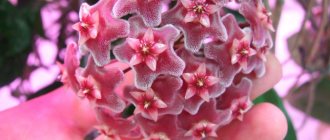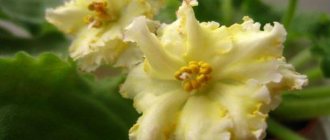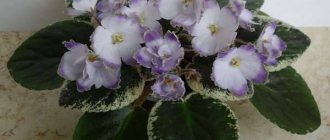Saintpaulia is better known among people as Uzambara violet. Uzambaros (South Africa) is the place of origin of the variety, and the houseplant is called violet because of its similarity to a garden flower with the same name. Today we will present to you some varieties of violets with descriptions, photos and names, and also tell you about growing and caring for this indoor plant.
Varieties of indoor violets 2. Propagation of Saintpaulia 3. Lighting Saintpaulia 4. Watering and bathing Uzambara violets 4.1 Wick watering 4.2 Watering in a tray 4.3 Watering under the leaves 4.4 How to bathe Saintpaulia 5. Caring for violets 5.1 Which soil to choose 5.2 Optimal temperature for growing 5.3 Pot for violets
Photo: Saintpaulia is the correct name for indoor violet.
Name of Saintpaulia varieties
The plant was named Saintpaulia in honor of its discoverer, the German Baron Ulrich von Saint-Paul. Despite the external similarity of the Uzambara violet to a garden flower, the plants have little in common: the second belongs to the violet family, and the first to the Gesneriaceae family. They also have different methods of reproduction and cultivation.
| Interesting. In nature, yellow Saintpaulia does not exist. |
Selection does not stand still. Today you can collect a collection of indoor violets of various colors: white, pink and even yellow. Today there are more than 20 thousand registered species alone. Below we have presented a description of some varieties of Saintpaulia.
Violet VaT-Dark Lady
The plant of this variety has a fairly large rosette, reaching up to 35 cm in diameter. It has beautiful variegated leaves and double large purple flowers, sometimes with pink dashes.
Photo: Saintpaulia “Dark Lady”.
Violet Dn-Royal Star
The violet variety has large flowers with “fantasy” pink polka dots.
Photo: Dn-Royal Star variety.
TS-Fairy's Gift
An exclusive variety – chimera. This means that a contrasting stripe of some color runs along the petals or flowers of the plant. Its peculiarity is that it reproduces only by stepsons from a peduncle or from shoots. Due to a combination of genes, the chimera cannot reproduce by leaf, like other varieties of violets.
Photo: chimera violet “Fairy’s Gift”.
NK-French Boulevard
Saintpaulia of this variety has an interesting color with white spots and a green border, which does not disappear with temperature changes, which often happens with other varieties of violets.
Photo: violet “French Boulevard”.
LE-Vanilla Parfait
This variety is interesting for its milky color of flowers and yellow impregnation, which is not often found in violets. It is very difficult to breed yellow Saintpaulia.
Photo: “Vanilla Parfait” variety.
Le-Brilliant Tiffany
This is an almost entirely yellow violet. The white color extends only along the edges of the petals. The green border sets off the yellow color and gives it a more saturated shade.
Photo: yellow Saintpaulia "Tiffany Diamond".
LF-Tenderness of the Princess
The variety is interesting in the form of flowers with a ruffled ruffle. The color of the plants varies from completely pink with a white border to white.
Photo: Saintpaulia variety “Tenderness of the Princess”.
Reviews
Olesya Sergeevna. “ I really like all the varieties of K. Morev, and the violet “Pink Watercolor” is my talisman, my collection began with it. I grew my beauty from a leaf petiole without any experience. And this means that any beginner can easily cope with caring for this violet. And its exceptional flowering will delight you for many years.”
The presented violet inspires thousands of flower growers.
How to propagate violets
Violets reproduce by leaf. The colors of solid varieties will be transmitted with a 99% probability. If Saintpaulia flowers have a bright multi-colored color, border or multicolor, they may not bloom according to the variety. This is called flowering sport. That is, the color of the petals will differ for each plant obtained during the propagation process.
Photo: violet propagation by leaf.
The greatest likelihood of passing on parental characteristics is provided by rearing from stepchildren. Stepchildren are small rosettes that grow between the leaves.
Sometimes violets are propagated by flower stalks. Their bracts also give a 99% chance of transmitting traits. In this case, the peduncle itself is planted, but its flowers are torn off, leaving a small stump. The petiole is broken off and used as planting material. Small Saintpaulias will grow in the axils between the bract and the stem.
Photo: new Saintpaulias will grow from this small part of the flower plant.
Main characteristics
Let's look at the key features of the variety presented in the table:
| Parameter | Characteristic |
| Culture | Rose (Rosa L.) |
| Variety | “Polka” (Polka, Polka 91, MEItosier, Lord Byron, Scented Dawn, Twilight Glow) |
| Garden group | Largeflowered Climber (LCL) |
| Form | Bush |
| Life cycle | perennial |
| Purpose | Decorative |
| Reproduction | Vegetative (by cuttings) |
| Bush height | 120-350 cm |
| Flowering type | Reblooming |
| Flowering period | June – September |
| Type of flower | Dense double |
| Number of petals | 65-100 pcs. |
| Flower diameter | 7-12 cm |
| Petal coloring | Apricot |
| Disease resistance | Average |
| Frost resistance | Up to −23 ℃ |
| Registration in the State Register | Absent |
Sustainability
To diseases
- Resistant to powdery mildew
- Medium resistance to black spot
- Rust resistant.
Resistance to climatic conditions
- Flowers fade slightly in the sun
- Flowers are not damaged by rain
- Tolerates spring frosts with minimal damage.
Advantages and disadvantages
The advantages of the rose bush rose polka include:
- produces a large number of buds, which ensures continuous flowering throughout the summer;
- the polka rose variety easily tolerates low air temperatures;
- leaves are large with a shiny dark green surface;
- the bush grows rapidly;
- The climbing rose variety Polka is resistant to fungal diseases.
Despite the advantages of the bush, there are also disadvantages:
- the branches are very fragile and break in strong gusts of wind;
- when there is drought, the buds wither;
- without fertilizers the bush will stop blooming;
- does not like clay and sandy soil types;
- does not take root well in lowlands where there is too much moisture.
Lighting violets
Uzambara violets require good lighting: 8-10 hours of high-quality light. Therefore, in winter it is necessary to grow them on a window with additional lighting with a certain number of lumens.
With comfortable lighting, Saintpaulias grow with an even flat rosette and good strong peduncles. If the plant does not have enough light, the leaves will begin to stretch upward. This affects the shape of the rosette and peduncles. They will not be able to grow stronger and develop properly; they will lie down on the rosette.
And in the summer, Saintpaulia on the windowsill can receive an excess of light. For comfortable development, it must be protected from direct sunlight with roller blinds or tulle that diffuses light. Eastern windows are best suited for violets, but even on them it is recommended to shade the flowers in the morning.
Photo: in good light, violets grow lush with a flat rosette and large peduncles.
How to properly water and bathe Saintpaulia
Watering indoor violets is carried out using different methods.
Wick watering
You can organize wick watering: a small glass with a plant is placed in a larger diameter container with a nutrient solution, into which a string is inserted from below. With its help, moisture enters the soil.
The nutrient solution for wick irrigation consists of water and fertilizer. But for this method of watering, 5-7 times less fertilizer is added than indicated in the instructions for it. This method also requires soil of a special composition: clean high-moor peat and a large amount of rippers. Perlite or foam balls are suitable as rippers.
Photo: wick watering of Uzambara violet.
Watering into a tray
It is carried out by growing Saintpaulia in a pot with a special tray into which water will be poured. It is important that it does not stagnate in the pan. So if, after a while after watering, the water does not leave the pan, it must be drained. Otherwise, rotting of the root system may occur, as a result of which the rosette may die.
When watering in the tray and under the leaves, use a purchased universal substrate. It is not recommended to use soils intended specifically for violets: it will be difficult for the delicate roots of plants to get used to them.
Watering under the leaves of the plant
It is done very carefully along the edge of the outlet or at its base. You should not pour water into the center of the outlet: the sheets there are very fragile and delicate. Moisture can damage them.
How to bathe a violet
Saintpaulias can be sprayed and bathed during the period of active growth of young plants. You should not bathe them more than once every six months.
After bathing, the flower must be protected from light, allowing it to dry in a dark place. Drops of water remaining on the sheets, combined with light, can work like a magnifying glass and burn the plant.
Photo: Saintpaulia bathing.
Timing of sowing seeds
Garden violet seeds can be sown in open ground in late autumn or seedlings can be grown from late winter to mid-spring.
You can either buy material for sowing, or, if viola is already growing in your garden, cut down the plant: use a toothpick to transfer pollen from the pistils to the stamens, resulting in ready-made seeds in a year or six months.
Sowing should be done from February to April in boxes or pots with nutritious soil, which should be steamed or sprayed with a fungicide solution before use to avoid the formation of fungus.
The seeds are evenly scattered into the prepared soil into pre-prepared shallow grooves, after which the soil is sifted through a sieve, covering the ground by 2-3 mm.
The sown violet must be watered and covered with film or glass to create a greenhouse effect. In this case, the room temperature should be at least 12°C and no more than 18°C.
You may also be interested: Secrets of growing pelargonium from seeds
Growing and caring for violets
If the rosettes do not bloom, they are watered with fertilizers with a high nitrogen content so that the violet grows leaf mass. When it gets ready to bloom, you can water it with potassium fertilizer. This will increase the number of peduncles and the quality of flowering. For everyday feeding, use any universal fertilizer for flowering plants.
| On a note. Liquid fertilizers are more convenient to dilute and dose than dry ones. |
Soil for Saintpaulia
The soil should be chosen to be breathable, initially loose or with a large number of rippers. This is necessary so that the violet roots receive enough oxygen. The plant should be aerated constantly, and the water should not stagnate.
Temperature for growing violets
Optimal temperature for growing Saintpaulias: 20-24 degrees. At temperatures below normal, the rosette becomes overcooled, and in extreme heat, plant growth slows down, increasing the risk of developing fungal diseases.
To prevent spots from appearing on the leaves of the plant, it should be protected from drafts. In winter, the ingress of cold air onto violets is minimized by insulating them with a heat insulator or moving them away from windows during ventilation.
Photo: violet should be grown in certain temperature conditions.
Landing in the ground
Plants should be planted in a sunny place, protected from drafts and wind.
The soil of the flowerbed should be well-drained, mulched with peat and humus.
In addition, you should regularly add a solution of complex fertilizers to each bush every two to three weeks.
If you decide to sow directly into open ground, you should do this with fresh seeds treated with a fungicidal agent at the turn of summer and autumn.
The soil should be loose and fertilized.
It is important to understand that the seedlings that disappeared in winter simply did not pass natural selection: but you will only have strong plants that can later be propagated by cuttings. Such plants will bloom for the first time in the second year after sowing.











